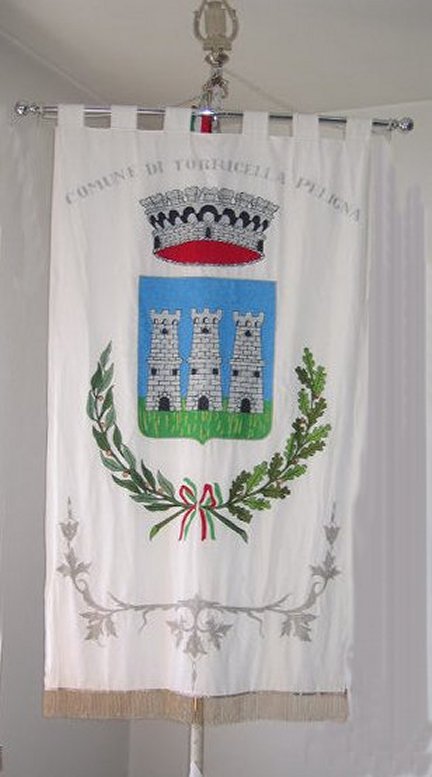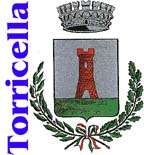

Gonfalone (Gonfalon) Stemma (Coat of Arms)
|
|
|
|
|
Scultura di
pietra al lato del Campanile Stone carving on the side of the bell tower |
||
|
|
|
|
|
Scultura di
pietra al lato destro dell’entrata della Sala Parrocchiale |
||
Il Gonfalone di Torricella Peligna fu attribuito al Comune dopo l’unificazione d’Italia per mezzo del Regio Decreto del 22 gennaio 1863. Le tre torri che si osservano all’interno dello stemma centrale gli furono attribuite dell’Istituto di Araldica di Genova, che è quello ufficiale, proprio in funzione del suo castello con tre torri.
Le torri erano innalzate per la difesa di città, castelli,
palazzi: le mura delle fortezze erano coronate da torri. La torre
rappresenta un baluardo che si oppone agli assalti dei nemici, ma
simboleggia anche forza morale. Lo stesso Dante Alighieri, nella Divina
Commedia, scrive: “E stetti come torre che giammai non crolla per soffiar
di venti”. Torricella Peligna è stata una roccaforte del popolo dei Peligni
ed ancora si vedrebbe il suo castello con le torri se non fosse stato
distrutto, da cui il simbolo sul suo Gonfalone.
Nel Gonfalone la prima cosa che appare in alto, sotto la scritta, è una
corona di argento attribuitagli dal Re d’Italia nel 1861 perché, a
quell’epoca, Torricella Peligna era già un Comune. I colori del Gonfalone
sono il bianco ed il blu: Il bianco significa “sotto la neve”. Il blu
significa “sotto il cielo”.
Le fronde che si osservano in basso al Gonfalone sono: a sinistra, fronde di ulivo, a destra, fronde di quercia. Il colore delle fronde è il verde olivo ed il verde quercia; colori delle due piante. Intorno alle foglie, però, i frutti sono palline argentate. E’ una rappresentazione dell’Istituto di Araldica a dimostrare che il Comune è stato fregiato delle fronde d’argento. Alcuni comuni le hanno ricevute d’oro, ma sono comuni meritevoli di qualcosa di eccezionale a giudizio del Re d’Italia dell’epoca. Al disotto del Gonfalone ci sono anche dei fregi di argento che scendono verso il basso, anch’essi a dimostrare la stessa cosa.
Dopo la seconda guerra mondiale il Comune di Torricella fece richiesta al Presidente della Repubblica di una medaglia d’oro al valor militare per le vittime civili che, però, le fu concessa di bronzo nell’anno 1980. Tale medaglia è appesa al Gonfalone durante le sfilate ufficiali.
L’olivo rappresenta la pace. Effettivamente un ramoscello di
olivo si offre come simbolo di pace. La quercia, albero secolare, forma
boschi in collina e sui monti. Il suo frutto, la ghianda, è un alimento per
gli animali sia domestici che selvaggi. La quercia simboleggia forza,
vigore, potenza, ma anche forza interiore. Si usa dire: ”E’ solido come una
quercia”.
In sostanza il Gonfalone di Torricella Peligna simboleggia forza e potere,
ma amministrato con saggezza e sempre pronto alla pace: “Forte e Gentile”.
The Gonfalon* of Torricella Peligna was bestowed on the town after the Unification of Italy by means of a Royal Decree on January 22, 1863. The three towers in the center of the coat of arms were officially conferred by the Heraldic Institute of Genoa precisely because Torricella had a castle with three towers.
Towers were erected to defend cities, castles and palaces. The walls of these fortresses were crowned with towers. The tower represents a bulwark that counters enemy assaults, and it also symbolizes moral strength. In the Divine Comedy Dante Alighieri writes: “And stand steadfast like towers that never topple over from the blowing of the winds.” Torricella Peligna was a stronghold of the Peligni people, and its castle with towers, as symbolized on the Gonfalon, would still be visible if it had not been destroyed.
On the Gonfalon the first thing that appears under the writing is a silver crown conferred on Torricella Peligna by the King of Italy in 1861 because at the time it was already an official municipality. The colors of the Gonfalon are white and blue, white signifying “under the snow” and blue “under the sun”.
The frond on the bottom left of the Gonfalon is that of an olive tree, and the one on the bottom right is that of an oak tree. The fronds are olive green and oak green in color, respectively. Interspersed with the leaves is round, silver-colored fruit. In this way the Heraldic Institute recognizes that Torricella Peligna had been the recipient of the honorific silver fronds. Some municipalities were bestowed with golden fronds because the King of Italy of the time determined such municipalities were exceptional in some way. At the bottom of the Gonfalon there are other adornments of the same honorific silver color.
After WWII Torricella Peligna asked the President of the Republic for a Gold Medal of Military Valor for the civilian victims, but instead, a bronze medal was conferred in 1980. That medal is hung from the Gonfalon during official parades.
The olive represents peace. In fact, a sprig from an olive tree is offered as a symbol of peace. Ageless oak forests cover hills and mountains. Oak bears acorns that feed both domestic and wild animals. It symbolizes strength, vigor, power, and also internal fortitude, as in the expression: “As solid as an oak.”
In essence, the Gonfalon of Torricella Peligna symbolizes strength and power, but administered with wisdom and peace: “Strong, but Kind.”
* The gonfalon or gonfalone (from the early Italian confalone), is a long flag or banner, often pointed, swallow-tailed, or with several streamers, and suspended from a crossbar. It was first adopted by Italian medieval communes, and, later, by local Guilds, Corporations and Districts.
It can be designed with a badge or coat of arms, or ornamented with a fancy design. Today every Italian comune (municipality) has a gonfalone sporting its coat of arms.
The gonfalon has long been used for ecclesiastical ceremonies and processions. The papal "ombrelino", a symbol of the pope is often mistakenly called "gonfalone" by the Italians because the pope's ceremonial umbrella was often depicted on the banner.
Gonfaloni was originally the name given to local community, or neighborhood, meetings in medieval Florence, each 'neighborhood' had its own flag and coat of arms, and the word gonfalone eventually became associated with the flag.
English translation courtesy of Dan Aspromonte